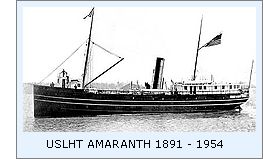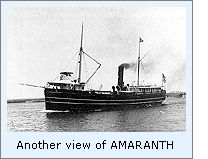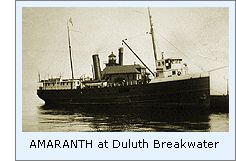|
As the final decade of the nineteenth century dawned, the Lighthouse Board found itself hard-pressed to keep up with construction, supply and inspection of the growing number of lights in the Ninth and Eleventh Districts. Perhaps more importantly, the Ninth District headquarters were located on the Chicago waterfront, and with the Colombian Exhibition slated to be held in Chicago in 1893, the world would be coming to Chicago, and with the Lighthouse Board scheduled to participate with a large display, the new tender would serve as a showpiece of the United State's growing prominence in the scene of international aids to navigation. To this end, the Board proposed an appropriation of $95,000 for the construction of a faster and larger tender for use in both districts.
Designed as a schooner-rigged vessel with a steel hull, she was to be 166 feet in length with a beam of 28 feet, drawing 11 feet 6 inches, and would displace 1,053 tons. Her single screw was to be driven by a compound inverted reciprocating steam engine fired by twin Scotch-type coal fired boilers. Launched on December 18, 1891, her machinery received a dock trial on March 5 in which the engines worked over four hours, developing a mean 105 pounds of steam pressure. The boilers were tight and it was found that she steamed easily, and that the engines worked well. With her power plant functioning properly, work continued on her cabins and deck equipment Her large fore hold was designed to provide a freight capacity of 550 tons, and she was equipped with a smaller ballast tank hold for convenience in loading and trimming and for holding potable water. Featuring convenient sleeping and mess accommodations for all hands, with one bathroom forward for the hands, another aft on the main deck for the officers, and a third in the upper deck cabin, she was also well lighted for her time, with a complement of 127 electric lights on five circuits, powered by a 100 light dynamo. Steam capstans both fore and aft and a fast running 10-ton hoist on the upper deck prepared her for both buoy handling and for loading and unloading building materials and supplies.
She was immediately pressed into service in both the Ninth and Eleventh Lighthouse Districts, and was instrumental in the construction of Squaw Island, Old Mackinac Point, Forty Mile Point Lights, among many others. In 1898, she steamed a record 12,055 miles servicing the two districts, consuming 990 net tons of coal. She wintered at the Detroit Depot every year, maintaining steam throughout the winter to help heat the buildings and to provide pressure for fire protection. In 1900 the AMARANTH was permanently assigned to the Eleventh District, where her spar, quarter, and main decks were completely renewed, all of her internal piping was completely replaced, and her shaking grates were replaced. As part of the First World Was effort, AMARANTH was transferred to the Navy By executive order on April 16, 1917 and was assigned to the Ninth Naval District, where she basically carried on her previous duties of supply and construction throughout the district. With the end of the war, she was transferred back to the Department of Commerce on July 1, 1919.
|
 Perceiving that the amount
of the request was excessive for the requirements as presented, Congress
appropriated the sum of $75,000 for the project on August 30 of that
year. Bids for the vessel's construction were advertised that fall, with
the Cleveland Ship Building Company being awarded the contract on May
10, 1891, with the understanding that the vessel would be complete by
January 1, 1892.
Perceiving that the amount
of the request was excessive for the requirements as presented, Congress
appropriated the sum of $75,000 for the project on August 30 of that
year. Bids for the vessel's construction were advertised that fall, with
the Cleveland Ship Building Company being awarded the contract on May
10, 1891, with the understanding that the vessel would be complete by
January 1, 1892. With work on the vessel
complete, at a total cost of $74,993.70, the contractor delivered the
vessel to the Detroit Depot on April 14, 1892. During the trip up Lake
Erie from Cleveland, she attained a speed of 12.2 miles per hour on the
open lake with a wind abeam and blowing a moderate gale. Her maximum
deviation observed was 15° on either side of the perpendicular, and her speed
from Bar Point to Detroit was 12.25 miles per hour, which when factored
by the speed of the rivers' current equated to a speed of 14 miles per
hour in smooth water.
With work on the vessel
complete, at a total cost of $74,993.70, the contractor delivered the
vessel to the Detroit Depot on April 14, 1892. During the trip up Lake
Erie from Cleveland, she attained a speed of 12.2 miles per hour on the
open lake with a wind abeam and blowing a moderate gale. Her maximum
deviation observed was 15° on either side of the perpendicular, and her speed
from Bar Point to Detroit was 12.25 miles per hour, which when factored
by the speed of the rivers' current equated to a speed of 14 miles per
hour in smooth water. With the transfer of
responsibility for the nation's aids to navigation to the Coast Guard in
1939, AMARANTH was designated as WAGL-201, and assigned to
duty based out of the Duluth Buoy depot. After having served an
incredible 53 years faithful service to maritime interests on the
Great Lakes, she was decommissioned on September 29, 1945 and sold into
private ownership in October of the following year. Her here steam
boilers were removed and replaced with diesel engines, and renamed
SOUTHWIND,
she served commercial interests until 1954.
With the transfer of
responsibility for the nation's aids to navigation to the Coast Guard in
1939, AMARANTH was designated as WAGL-201, and assigned to
duty based out of the Duluth Buoy depot. After having served an
incredible 53 years faithful service to maritime interests on the
Great Lakes, she was decommissioned on September 29, 1945 and sold into
private ownership in October of the following year. Her here steam
boilers were removed and replaced with diesel engines, and renamed
SOUTHWIND,
she served commercial interests until 1954.